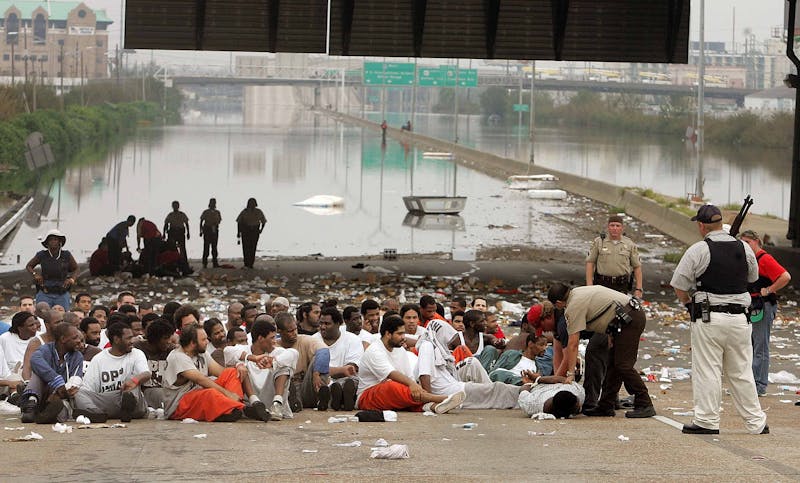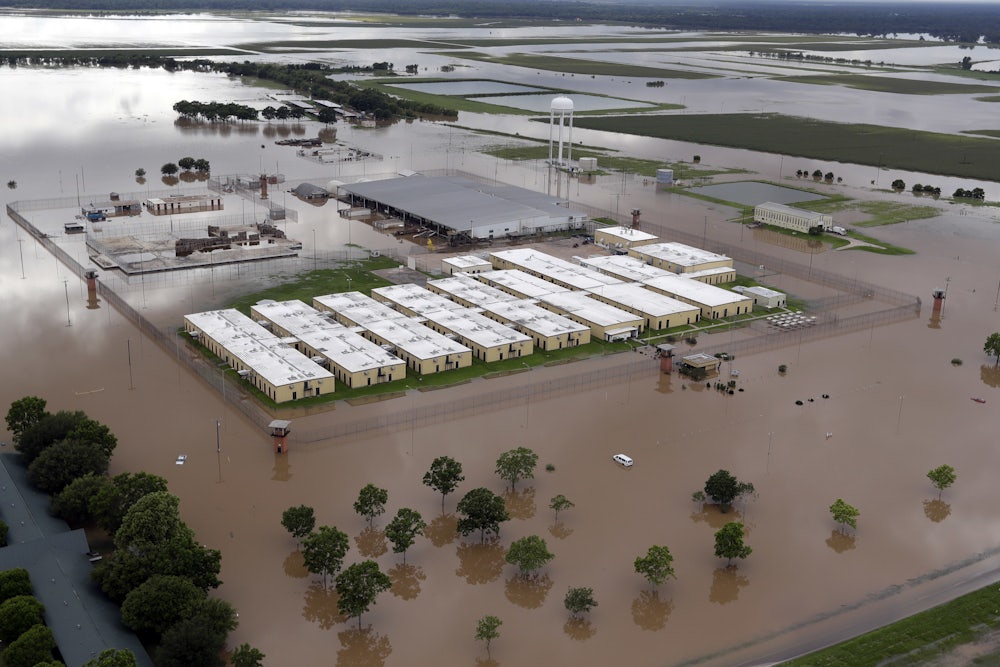Global warming far and away is the most pressing issue
facing the United States (and the rest of the planet). The fast-approaching
climate reckoning is bigger than the presidential election, bigger than our
imperialist forever wars, bigger even than the virulent fascist threat that’s
taken root in the White House and spread its tendrils across the globe. It is
no longer an exaggeration to say that the world is dying. Time is running out
to pull back from the point of no return before it swallows us all whole.
For millions of Americans, that point is already here—and unlike the majority of people, they have no way to escape its horrors. When natural disasters hit, incarcerated people are often the first to be abandoned; as the climate crisis worsens, so will their suffering. The specter of climate change is a hazardous fact of life for the prisoners forced to labor in sweltering Texas fields, the ones fighting wildfires for pennies in California, and those recently left trapped in the path of Hurricane Dorian when South Carolina prison officials declined to evacuate them ahead of the storm.
And yet incarcerated people have been largely left out of the conversations around ambitious climate justice proposals like the Green New Deal, which neglects to engage with decarceration, prison abolition, or demilitarization. Nor do its lead advocates say much to specifically address what’s already happening inside the country’s prisons. The top demand in 2018’s national prison strike was to create “immediate improvements to the conditions of prisons and prison policies that recognize the humanity of imprisoned men and women.” A year later, not only are those basic demands left unmet, but the number of incarcerated people who’ve died preventable, climate-related deaths have continued to increase.
“When we think about the increasingly genocidal climate crisis, it’s important to understand that prisoners and detainees are literally on the front lines,” says prison abolitionist and organizer Jay Ware. It’s the imprisoned who suffer the greatest blows of climate-related catastrophe, he notes, “whether this is families fleeing climate change in the Global South being detained and separated into immigrant detention facilities or other black, brown, and poor white prisoners from typically toxic neighborhoods ecologically who are held in toxic prisons.”
Climate vulnerabilities continue to intensify as paralyzing natural disasters multiply and occur with greater frequency, all while the U.S. government does nothing to curb the breakdown of the climate. “Every single day is a climate, weather, and environmental related disaster for people in prison,” said a member-organizer of the Incarcerated Workers Organizing Committee (IWOC) who requested anonymity to minimize their risk of retaliation from prison officials. IWOC is a prisoner-led section of the Industrial Workers of the World that coordinates inside and outside of prison walls to support incarcerated and formerly incarcerated people and abolish prison slavery.
The devastation of climate disaster does not threaten the lives of the incarcerated all by itself; rather, IWOC says that the onus lies on prison officials who place inmates in the direct path of environmental harm. As record-breaking temperatures continue to heat up the outside world, the people who are kept inside cages of concrete and steel, with no control over their conditions or ability to leave, are powerless to escape its effects. (This is especially the case for those in solitary confinement, a practice the U.N. recognizes as torture.)
A 2015 report by the Sabin Center on Climate Change at Columbia University studied the ways in which the conditions inside U.S. jails and prisons compound the adverse effects of global warming. “Rising temperatures and increasingly harsh extreme-heat events will jeopardize the health of inmates and correctional officers alike, and will stress the physical plant of the correctional sector,” the study found. “The success or failure of correctional adaptation efforts will be measured in human lives as well as public dollars.”
Many prisons are old, and were constructed out of heat-retaining materials, which also magnifies climate-related harm for inmates. Prison facilities have their own negative ecological impact, and the link between mass incarceration and environmental destruction is well established. Recently, activists in Letcher County, Kentucky, successfully halted the construction of a new prison on the grounds that it would cause irreparable harm to the surrounding area, setting an important precedent for other environmental advocates.
Meanwhile, thousands of U.S. prisoners who are incarcerated in areas where temperatures regularly top 100 degrees still have no access to air-conditioning. Texas has air conditioning in only 30 of its 109 prisons—and over the past 14 years, 22 people imprisoned in Texas have died due to extreme heat. The same pattern holds in hot spots like Arizona, Florida, the Carolinas, and the eight other states that lack universal air conditioning within prison housing facilities. Thanks to the widespread neglect of basic protections against extreme heat, there’s no reliable count of the number of prisoners who have been cooked to death in recent years. Prisoners with preexisting medical or mental health issues are uniquely vulnerable to extreme temperatures, and all are at risk of dehydration and heat stroke. Meanwhile, July 2019 was recorded as the hottest month in human history.
Nor do the changing seasons offer much respite; rather, they present their own set of dangers. When the heat went out in Brooklyn’s Metropolitan Detention Center during a February 2019 cold snap, prisoners were left to freeze for almost a full week before officials, amid public outcry, turned the electricity back on. Visitors—who included several New York state representatives and city officials—described a cold, dark, miserable setting. Governor Andrew Cuomo called it “a violation of human decency and dignity.” Prisoners reported a lack of heating and hot water and no lights in their cells, and the sick went without medical care. Desperate, they banged on the bars of their cells, hoping to catch the attention of protestors outside.
Then, more and more often, there are storms. Every time a large-scale hurricane approaches a coastal stretch of the United States, gruesome stories surface concerning prison officials who refuse to evacuate their prisons. The consequences of this malign neglect can be devastating, and sometimes fatal. During Hurricane Katrina, thousands of prisoners were left to rot in waist-high water; in 2017, Hurricane Harvey saw 3,000 prisoners in Texas stranded without food or water for days; in 2018, prisoners within the evacuation zone on Florida’s coast were left to fend for themselves when Hurricane Michael hit; and when Hurricane Florence rolled through South Carolina, the state declined to evacuate more than a thousand people across multiple prisons. Two mentally ill women prisoners who were being transported between South Carolina facilities drowned when the transport van carrying them was swept away by the storm.

Even when prisoners survive the storm itself, the aftermath can be deadly, thanks to institutional violence and neglect, while the squalid conditions that exist at many prisons in the path of climate disaster are made much worse by flooding. The specter of disease often carries off more souls than the wind or flood waters. “It’s not just being in the path of storms or disasters themselves—it’s the lack of ability to obtain clean water, air, and food, and lack of ability to leave dangerous situations and get to safety: that is the gravest danger” facing incarcerated people, according to the IWOC organizer.
“Diseases like cholera have spread in prisons around the world, and it’s a ticking time bomb until we have a massive outbreak in a US prison or jail related to environmental issues,” Ware adds. “E Coli, dysentery—there are so many diseases that can be spread in prisons on a so-called ‘good day,’ but they increase astronomically when you have prisoners forced to drink contaminated water and live in sewage. And we know that this is what happens when prisoners are left in disaster zones.”
After the immediate danger of an extreme weather event has passed, prisoners are often used as slave labor to clean up the areas devastated by a major storm. As they carry off the sandbags they made and piled up before a storm’s coastal onslaught, or handle toxic materials amid a hurricane’s wreckage, they are exposed to still more risk of disease, while their labor is stolen in order to restore a status quo that only comforts those outside the walls. “The reality is that the use of prison labor by the state in this way is not new at all,” Ware notes, “but that the need is increasing ... as things continue to get worse, prisoners will continue to be casualties of climate genocide.”
Many of American society’s greatest fears about the climate crisis—brutal heat waves and cold spells, natural disasters, widespread sickness, starvation, preventable death—have already come to pass, as storms command our national news cycles with increasing frequency. But the public at large is less aware of the ways that the burgeoning climate catastrophe is already laying waste to the country’s most vulnerable populations. Instead of heeding such pressing alarms, many of our political leaders and the members of our pundit class alternately bully teenage climate activists and fret over whether the crisis is “real”—or debate just how imminent climate disaster may prove to be.
Prison abolition is the only humane solution to this crisis, but until that day arrives, the absolute bare minimum that climate justice advocates can do is to make a real and concerted effort to listen to and center the voices of those who have already been thrust onto the front lines of a war they didn’t start. IWOC also urges people to join an abolition group, write letters to prisoners, take part in a phone zap, stage a protest, hold a noise demonstration outside a facility—in short, anything it takes to let the people inside know that they haven’t been forgotten as the world continues to burn.
“In order to transform into a society that survives climate change, we collectively need to be led by those who have survived the most harm,” the IWOC member explains. “So we need poor people, black people, black women, brown people, people who are refugees, to the front. People who have been in hell know how to prevail through hell. We all need that wisdom to survive the hell of this disaster of capitalism.”
